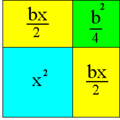Lession 2: Fractional Indices
Fractional Indices
introduction
In the previous lesson you learnt about positive indices.In this lesson you will be exposed to another aspect of indices i.e fractional indices.
| By the end of this lesson you should be able to
i)state laws of fractional indices ii)evaluate expressions in fractional indices |
Lesson Content
In this lesson you will be learning about cases when the indices are fractions .
From previous work; 51/2*51/2=51/2 + 1/2
=51=5(from laws of positive indices)
which means that(51/2)2=5 therefore,51/2=2√5
now look at the following example
81/3*81/3*81/3=81/3+1/3+1/3=81=8
Hence(81/3)3=8
therefore81/3=3√8
Similarly a1/3=3√a
In general a1/n=n√a
Consider also 82/3
Now 82/3*82/3*82/3=(82/3)3
=82/3*3/1=82
Now if (82/3)3=82Then 82/3= 3√82
(by taking cube roots on both sides) so in general a1/n =n√a
Therefore you have am/n=n√am
When m=1, then am/n=a1/n=n√a1 =n√a
Examples:Evaluate the following
i) 811/4
ii) 271/3 iii)(16/25)1/2
Solutions i) 811/4 =(34))1/4=31= 3
ii)271/3=(33)1/3=31=3
iii)(16/25)1/2= (42)1/2/(52)1/2
=41/51=4/5
- (81/16)3/4
- Solve following equation:2a2=16a-1
Maina 15:42, 26 February 2007 (CET)

